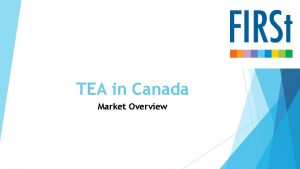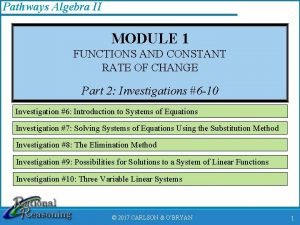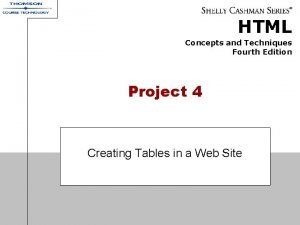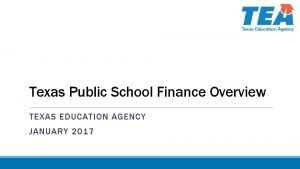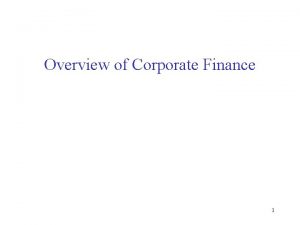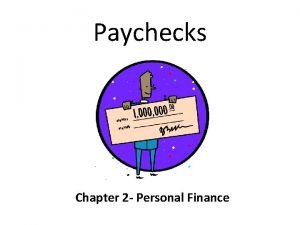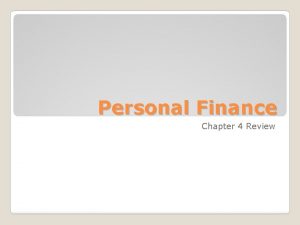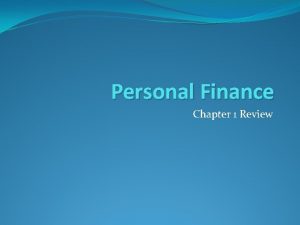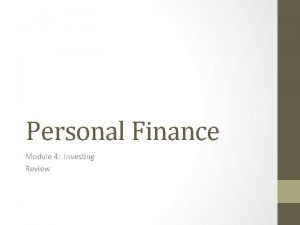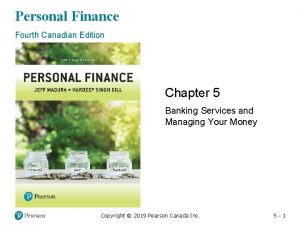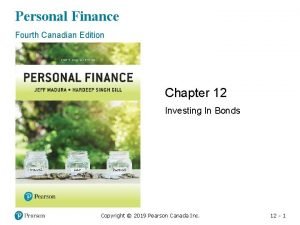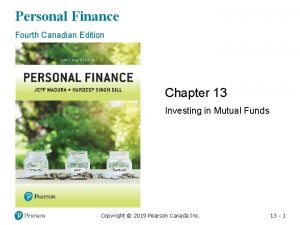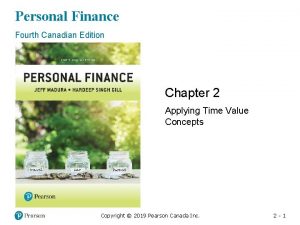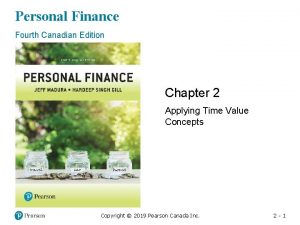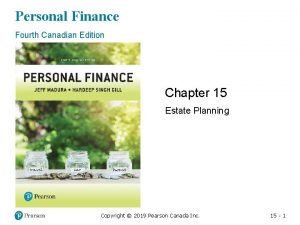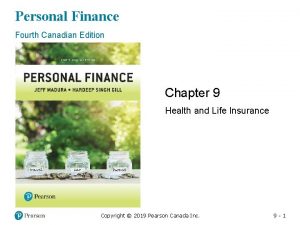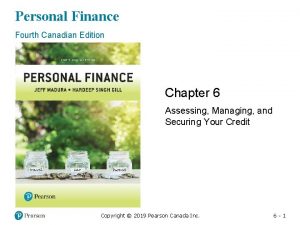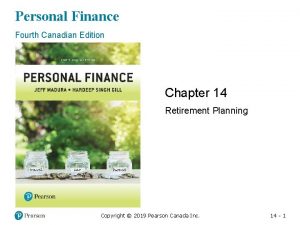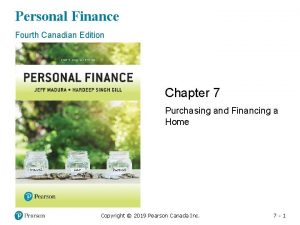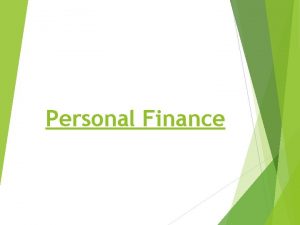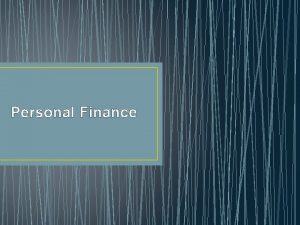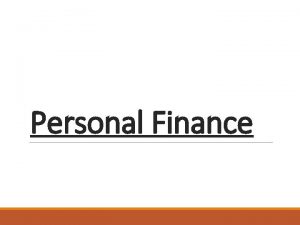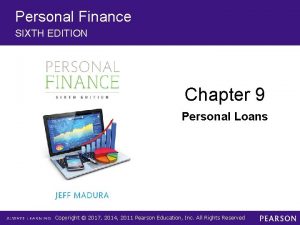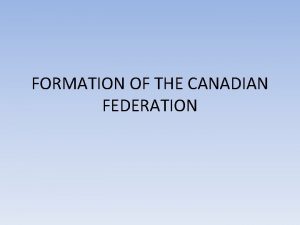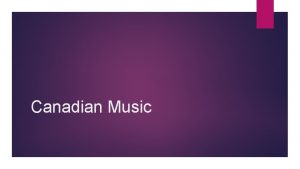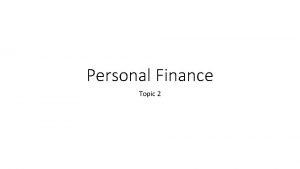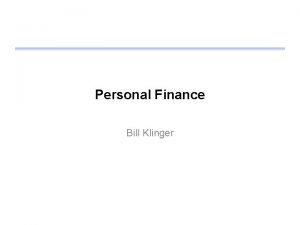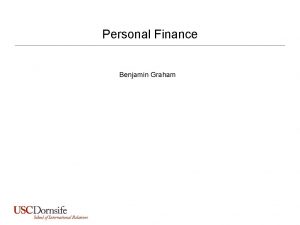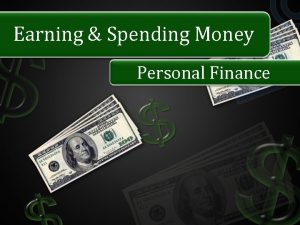Personal Finance Fourth Canadian Edition Chapter 1 Overview



































- Slides: 35

Personal Finance Fourth Canadian Edition Chapter 1 Overview of a Financial Plan Copyright © 2019 Pearson Canada Inc. 1 -1

Chapter Objectives • Explain how you could benefit from personal financial planning • Identify the key components of a financial plan • Outline the steps involved in developing your financial plan Copyright © 2019 Pearson Canada Inc. 1 -2

Definitions (1 of 2) • Personal Finance: the process of planning your spending, financing, and investing activities, while taking into account uncontrollable events such as death or disability, in order to optimize your financial situation over time. Copyright © 2019 Pearson Canada Inc. 1 -3

Definitions (2 of 2) • Personal Financial Plan: a plan that specifies your financial goals, describes the spending, financing, and investing activities that are intended to achieve those goals and the risk management strategies that are required to protect against uncontrollable events such as death or disability. Copyright © 2019 Pearson Canada Inc. 1 -4

Benefits of Understanding Personal Finance (1 of 2) • Make Informed Financial Decisions – Know there is an opportunity cost to your decisions – Opportunity cost: what you give up as a result of a decision • Judge the Advice of Financial Advisers – Is their advice in your best interest or theirs? – Use questions created by the Financial Planning Standards Council (FPSC) Copyright © 2019 Pearson Canada Inc. 1 -5

Benefits of Understanding Personal Finance (2 of 2) • Become a Financial Advisor – Take courses to gain the education and experience you need to become a financial adviser – Earn the Certified Financial Planner (CFP) designation – Education, examination, experience, and ethical requirements must be met Copyright © 2019 Pearson Canada Inc. 1 -6

Five Key Components of a Financial Plan 1. Budgeting and tax planning 2. Financing your purchases 3. Protecting your assets and income (insurance) 4. Investing your money 5. Planning your retirement and estate Copyright © 2019 Pearson Canada Inc. 1 -7

1. Budgeting and Tax Planning • Budget planning: The process of forecasting future income, expenses and savings goals • Evaluate your current financial position – – Income and expenses Assets: what you own Liabilities: what you owe; your debt Net worth: the value of what you own minus the value of what you owe Free App: i. Spending Copyright © 2019 Pearson Canada Inc. 1 -8

Typical Financial Planning Life Stages Age Group • Education • 0 to 22 • Early Career • 23 to 30 • Family and Mid Career • 31 to 49 • Prime Earning • 50 to 64 • Early Retirement • 65 to 74 • Late Retirement • 75+ Copyright © 2019 Pearson Canada Inc. 1 -9

Financial Planning Life Stages (1 of 2) Exhibit 1. 2 Typical Financial Planning Life Stages Blank Education Early Career Family and Mid. Career Age Group 0– 22 23– 30 31– 49 50– 64 65– 74 75+ § Establish good saving and spending habits § Consider saving money inside a TFSA § Establish a credit rating § Follow the pay -yourself-first principle § Pay off student loans and other short-term debt § Buy furnishings for a home § Buy a car § Consider a mutual fund, inside or outside an RRSP § Buy a home and review insurance needs (health, life, disability, critical illness) § Start a family § Open an RESP account § Continue with your RRSPs § Reduce/minimize taxes § Have a will and power of attorney § Investigate employer-based savings options § Start a business § Are all debts paid? § Have taxes been minimized? § Adequate savings? § Children’s education fund? § Weddings? § Job security? § Elder care? § What can you expect from OAS/CPP programs? § RRSP/LIRA/work place pension maturity options? § Account for all your assets § Retirement income distribution patterns § What happens if a spouse dies? § Changes to your will and power of attorney § RRSP/LIRA maturity options? § Annuitize assets? § Reverse mortgage? § Wealth management: how, who, where? § Estate planning Consider Your Current Financial Position Prime Earning Early Retirement Late Retirement Copyright © 2019 Pearson Canada Inc. 1 - 10

Financial Planning Life Stages (2 of 2) Exhibit 1. 2 Continued Life Stages Blank Age Group Milestones Education Early Career Family and Mid -Career 0– 22 23– 30 31– 49 § Graduation § First job § New job/Raise § Marriage § First house § First baby § Divorce Prime Earning Early Retirement Late Retirement 50– 64 65– 74 75+ § Empty nest § Parental care § Close to retirement Copyright © 2019 Pearson Canada Inc. § Retirement § Empty nest § Travel § Parental care Blank 1 - 11

2. Financing Your Purchases • Liquidity: your access to ready cash, including savings and credit, to cover short-term or unexpected expenses • Money management: decisions regarding how much money to retain in liquid form and how to allocate the funds among short-term investment instruments Copyright © 2019 Pearson Canada Inc. 1 - 12

Managing Your Financial Resources (1 of 4) • Emergency fund: a portion of savings that you have allocated to short-term needs such as unexpected expenses in order to maintain adequate liquidity • Credit management: decisions regarding how much credit to obtain to support your spending and which sources of credit to use Copyright © 2019 Pearson Canada Inc. 1 - 13

Managing Your Financial Resources (2 of 4) Copyright © 2019 Pearson Canada Inc. 1 - 14

Managing Your Financial Resources (3 of 4) • Loans often needed for large expenditures – University or college tuition, car, home • Managing loans – How much can you afford to borrow? – Determining maturity of the loan – Selecting a loan with a competitive interest rate Copyright © 2019 Pearson Canada Inc. 1 - 15

Managing Your Financial Resources (4 of 4) Copyright © 2019 Pearson Canada Inc. 1 - 16

3. Protecting Your Assets and Income • Risk: Exposure to events (or perils) that can cause a financial loss • Risk management: decisions about whether and how to protect against risk • Insurance planning: determining the types and amount of insurance needed to protect your assets and/or income Copyright © 2019 Pearson Canada Inc. 1 - 17

4. Investing Your Money • Any savings you have beyond what you need to maintain liquidity should be invested to earn a return – Stocks, bonds, mutual funds, real estate • Investment risk: uncertainty surrounding the potential return on an investment and its future potential value • Risk tolerance: your ability to accept potential losses (of return and/or capital) Copyright © 2019 Pearson Canada Inc. 1 - 18

5. Planning Your Retirement and Estate • Retirement planning: determining how much money should be set aside each year for retirement and how those funds should be invested • Estate planning: determining how your wealth will be distributed before and/or after your death Copyright © 2019 Pearson Canada Inc. 1 - 19

Components of Your Financial Plan Copyright © 2019 Pearson Canada Inc. 1 - 20

How the Textbook Relates to the Financial Plan Components • Each of the five parts of the textbook covers one specific component of a financial plan • Follow the steps in the textbook to complete a financial plan for yourself by the end of the course Copyright © 2019 Pearson Canada Inc. 1 - 21

Exhibit 1. 6 Example of Decision Made in Each Component of a Financial Plan A Plan for: Types of Decisions 1. Managing your income What expenses should you anticipate? How much money should you attempt to save each month? How much money must you save each month toward a specific purchase? What debt payments must you make each month? How much money should you maintain in your bank account? 2. Managing your financial resources Should you use credit cards as a means of borrowing money? How much money can you borrow to purchase a car? Should you borrow money to purchase a car or should you lease a car? How much money can you borrow to purchase a home? 3. Protecting your assets and income What type of mortgage loan should you obtain to finance the purchase of a house? What type of insurance do you need? 4. Investing How much insurance do you need? How much money should you allocate toward investments? What types of investments should you consider? 5. Planning your retirement and estate How much risk can you tolerate when investing your money? How much money will you need for retirement? How much money must you save each year so that you can retire in a specific year? How will you allocate your estate among your heirs? Copyright © 2019 Pearson Canada Inc. 1 - 22

How Financial Planning Affects Your Cash Flows Copyright © 2019 Pearson Canada Inc. 1 - 23

How the Components Relate to Your Cash Flows (1 of 2) • Income is cash that you receive • Expenses are cash that you spend • Budgeting focuses on income and spending • Financial management focuses on depositing funds to establish an emergency fund or obtaining credit for your purchases Copyright © 2019 Pearson Canada Inc. 1 - 24

How the Components Relate to Your Cash Flows (2 of 2) • Protecting your assets and income focuses on determining your insurance needs and spending money on insurance premiums • Investing uses some excess cash to build wealth • Retirement planning focuses on building wealth in your retirement account • Estate planning is used to determine how you will distribute your assets before and/or after your death Copyright © 2019 Pearson Canada Inc. 1 - 25

How Psychology Affects Your Financial Plan • What motivates your spending behaviour? – Achieving immediate satisfaction? Peer pressure? Spend excessively? Impulse purchases? “shopping or retail therapy”? – Strong desire to avoid debt? • Try the behavioural quiz in the textbook Copyright © 2019 Pearson Canada Inc. 1 - 26

Developing Your Financial Plan 1. Establish your financial goals 2. Consider your current financial position 3. Identify and evaluate alternative plans 4. Select and implement the best plan 5. Evaluate your financial plan 6. Revise your financial plan Copyright © 2019 Pearson Canada Inc. 1 - 27

Step 1. Establish Your Financial Goals (1 of 2) • Specify your goals – Ensure they are SMART (i. e. specific, measurable, actionable, realistic, and timely) • Measure your goals • Act on your goals Free App: goal. Getter • Set realistic goals • Timing of goals (short term- within next year, medium term- between one and five years, long term- beyond five years) Copyright © 2019 Pearson Canada Inc. 1 - 28

Step 1. Establish Your Financial Goals (2 of 2) Maeva loves to travel; so much so that she is planning a trip to Europe after high school graduation. After going online and researching the cost of her trip, she determines that she will need to save $3000 over the next two years. Next, she calculates how much she can earn if she works full-time over the next two summers and part-time during the school year. After speaking to her manager at work about adding shifts and discussing her travel budget with her parents to get their feedback, Maeva is confident that she can achieve her goal. She concludes that in two years’ time, she will be in a position to book airfare and have enough money saved for hotels, trains, food, and shopping for her European vacation. Maeva’s goal is a SMART goal since it meets each of the criteria set out above. It is specific in that she is saving for a trip to Europe after high school graduation. It is measurable since she has specified that she needs to save $3000. It is action-oriented since she has researched the cost, calculated the additional income she needs, spoken with her manager about adding shifts, and discussed her plan with her parents. Maeva’s research has let her to the conclusion that her plan is realistic. Finally, her plan is time bound since she wants to take the trip in the next two years. Copyright © 2019 Pearson Canada Inc. 1 - 29

Step 2. Consider Your Current Financial Position • How your future financial position is tied to your current level of debt – Individuals with lower levels of debt will make different decisions than someone who has mounting debt • How your future financial position is tied to your age and wealth – A 20 year-old with less assets will have a different financial plan than a 65 year-old with many assets Copyright © 2019 Pearson Canada Inc. 1 - 30

Step 3. Identify and Evaluate Alternative Plans That Could Achieve Your Goals • Plans could be conservative or aggressive • How much discipline is involved? • Is there a greater chance of failure due to risks involved? Copyright © 2019 Pearson Canada Inc. 1 - 31

Step 4. Select and Implement the Best Plan for Achieving Your Goals • Individuals in the same financial position with the same goals may select different plans – Saving a specific amount every month vs. making some risky investments – Influenced by your willingness to take risk and by your self-discipline • The internet has valuable financial planning information (the text has online exercises) Copyright © 2019 Pearson Canada Inc. 1 - 32

Step 5. Evaluate Your Financial Plan • Keep plan in an accessible place and monitor your progress Step 6. Revise Your Financial Plan • Change plan as financial conditions and financial goals change, or if you find it is unrealistic Copyright © 2019 Pearson Canada Inc. 1 - 33

Exhibit 1. 8 Summary of Steps Used to Develop a Financial Plan 1. Establish your SMART financial goals. § What are your short-term financial goals? § What are your medium-term financial goals? § What are your long-term financial goals? 2. Consider your current financial position. § How much money do you have in savings? § What is the value of your investments? § What is your net worth? 3. Identify and evaluate alternative plans that could achieve your goals. § Given your goals and existing financial position described in the previous steps, how can you obtain the necessary funds to achieve your financial goals? § Will you need to reduce your spending to save more money each month? § Will you need to make investments that generate a higher rate of return? 4. Select and implement the best plan for achieving your goals. § What are the advantages and disadvantages of each alternative plan that could be used to achieve your goals? 5. Evaluate your financial plan. § Is your financial plan working properly? That is, will it enable you to achieve your financial goals? 6. Revise your financial plan. § Have your financial goals changed? § Should parts of the financial plan be revised in order to increase the chance of achieving your financial goals? (If so, identify the parts that should be changed, and determine how they should be revised. ) Copyright © 2019 Pearson Canada Inc. 1 - 34

Focus on Ethics: Personal Financial Advice • Your objective is to get the best advice appropriate to your needs • Be wary of unethical behavior – Difficult to discern • Be wary of incompetent advice – Be alert, ask questions, carefully consider advice Copyright © 2019 Pearson Canada Inc. 1 - 35
 Fundamentals of corporate finance, third canadian edition
Fundamentals of corporate finance, third canadian edition Fundamentals of corporate finance canadian edition
Fundamentals of corporate finance canadian edition Overview of personal finance chapter 1
Overview of personal finance chapter 1 Chapter 1 overview of personal finance answers
Chapter 1 overview of personal finance answers Personal finance 6th edition
Personal finance 6th edition Tea market in canada
Tea market in canada Project 2 fourth edition
Project 2 fourth edition Pathways algebra 2 fourth edition answer key
Pathways algebra 2 fourth edition answer key Ethics in information technology fourth edition
Ethics in information technology fourth edition Ethics in information technology 6th edition answers
Ethics in information technology 6th edition answers Vertical line code in html
Vertical line code in html Discrete mathematics with applications fourth edition
Discrete mathematics with applications fourth edition Expert systems: principles and programming, fourth edition
Expert systems: principles and programming, fourth edition Marketing an introduction 6th canadian edition
Marketing an introduction 6th canadian edition Accounting principles second canadian edition
Accounting principles second canadian edition Accounting principles second canadian edition
Accounting principles second canadian edition Accounting principles second canadian edition
Accounting principles second canadian edition Accounting principles second canadian edition
Accounting principles second canadian edition Texas public school finance overview
Texas public school finance overview Texas public school finance overview
Texas public school finance overview Corporate finance overview
Corporate finance overview Corporate finance overview
Corporate finance overview Chapter 2 personal finance
Chapter 2 personal finance Chapter 8 personal finance
Chapter 8 personal finance Chapter 4 post test personal finance
Chapter 4 post test personal finance Personal finance chapter 1
Personal finance chapter 1 Corporate finance tenth edition
Corporate finance tenth edition Fundamentals of corporate finance fifth edition
Fundamentals of corporate finance fifth edition Fundamentals of corporate finance 6th edition
Fundamentals of corporate finance 6th edition Corporate finance tenth edition
Corporate finance tenth edition Corporate finance tenth edition
Corporate finance tenth edition Corporate finance tenth edition
Corporate finance tenth edition Corporate finance tenth edition
Corporate finance tenth edition Using mis 10th edition
Using mis 10th edition Mis
Mis Module 4 investing
Module 4 investing





